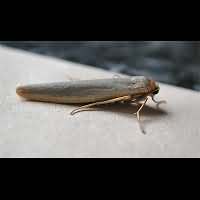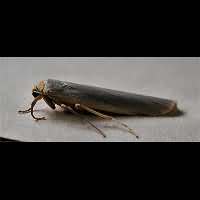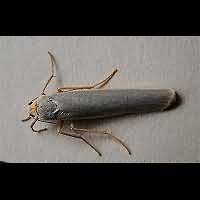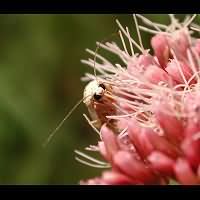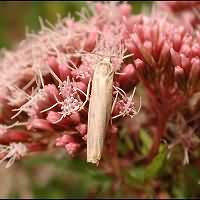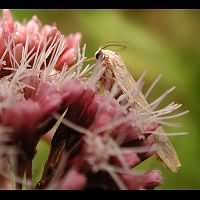Scarce Footman (Eilema complana)
The Scarce Footman is a typical greyish Footman and very similar to some other species. Identification is usually not extremely difficult, combining the following two characteristics. The wings are folded around the body and the orange line on the edge of the front wing doesn't taper towards the wing top, but remains more or less the same. Old and worn animals may look like Grass Moths, but differ by having no snout, where Grass Moths always have one. However very old and worn animals often can not be told apart anymore. Even though the wingspan is 30 to 36 mm, making this species about as big as most of the others, it makes the impression of being smaller, because of the way the wings are curled around the body.
The eggs are being laid in summer and hatch within 4 weeks after being deposited. The young caterpillars of the Scarce Footman do eat, but not a lot and they don't grow very fast during this stage. The still very small larvae overwinter sitting on bark or in lyches, not taking any apparent precautions against winter. In April they become active again, start eating again and now grow rapidly. From June they'll pupate. They'll spin a cocoon, usually in a crevice of bark or among leaflitter on the ground, where pupation takes 3 to 6 weeks. The caterpillar of the Scarce Footman is very similar to others: brown with a faint black dorsal line en orange dots on each segment. The head is black. It will reach a length of some 22 to 26 mm. It's main food are lichens on trees and shrubs, but when there is not enough food it probably eats leaves as well (bramble has been mentioned).
The Scarce Footman flies in summer (from the end of June to the middle of August) and is seen both at day and at night. Not only does it fly during the day frequently, it even feeds in broad daylight. In our garden regularly seen on Hempweed, elsewhere reported from thistles. Is easily attracted by light. When feeding it behaves very well indeed and often is willingly posing for the camera. Caught when resting it remains unrestful for a long time and may be difficult to photograph. Very common in most of England and Wales, a local species in Ireland.
For a long time it was believed the Northern Footman (Eilema sericea) was a separate species found in Northern parts of England, Wales and on the Isle of Man. Nowadays the Northern Footman is considered to be a mere local variety of the Scarce Footman, for there is no difference at all in the genitals. Also the caterpillars are absolutely identical. The main differences are the food of the larvae (mosses) and the darker, greyish hindwing in the adult moths.
The Scarce Footman is a typical greyish Footman and very similar to some other species. Identification is usually not extremely difficult, combining the following two characteristics. The wings are folded around the body and the orange line on the edge of the front wing doesn't taper towards the wing top, but remains more or less the same. Old and worn animals may look like Grass Moths, but differ by having no snout, where Grass Moths always have one. However very old and worn animals often can not be told apart anymore. Even though the wingspan is 30 to 36 mm, making this species about as big as most of the others, it makes the impression of being smaller, because of the way the wings are curled around the body.
The eggs are being laid in summer and hatch within 4 weeks after being deposited. The young caterpillars of the Scarce Footman do eat, but not a lot and they don't grow very fast during this stage. The still very small larvae overwinter sitting on bark or in lyches, not taking any apparent precautions against winter. In April they become active again, start eating again and now grow rapidly. From June they'll pupate. They'll spin a cocoon, usually in a crevice of bark or among leaflitter on the ground, where pupation takes 3 to 6 weeks. The caterpillar of the Scarce Footman is very similar to others: brown with a faint black dorsal line en orange dots on each segment. The head is black. It will reach a length of some 22 to 26 mm. It's main food are lichens on trees and shrubs, but when there is not enough food it probably eats leaves as well (bramble has been mentioned).
The Scarce Footman flies in summer (from the end of June to the middle of August) and is seen both at day and at night. Not only does it fly during the day frequently, it even feeds in broad daylight. In our garden regularly seen on Hempweed, elsewhere reported from thistles. Is easily attracted by light. When feeding it behaves very well indeed and often is willingly posing for the camera. Caught when resting it remains unrestful for a long time and may be difficult to photograph. Very common in most of England and Wales, a local species in Ireland.
For a long time it was believed the Northern Footman (Eilema sericea) was a separate species found in Northern parts of England, Wales and on the Isle of Man. Nowadays the Northern Footman is considered to be a mere local variety of the Scarce Footman, for there is no difference at all in the genitals. Also the caterpillars are absolutely identical. The main differences are the food of the larvae (mosses) and the darker, greyish hindwing in the adult moths.

